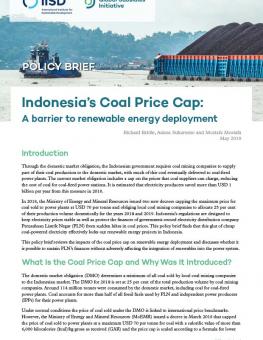
Indonesia's Coal Price Cap: A barrier to renewable energy deployment
Indonesia's coal price cap encourages the consumption of coal while slowing the integration of renewable energy into the country's power grid.
Indonesia's coal price cap encourages the consumption of coal while slowing the integration of renewable energy into the country's power grid.
Key Messages
- A price cap on mandatory sales of Indonesian coal to Perusahaan Listrik Negara (PLN), the state-owned electricity company, distorts the market and locks in coal consumption
- There are five other viable strategies to shore up PLN's finances without harming the integration of renewable energy into Indonesia's power supply
- While subsidy reforms may affect consumer power prices, there are additional strategies to offset these impacts
Indonesia requires coal mining companies to supply part of their coal production to the domestic market, with much of this coal eventually delivered to coal-fired power plants.
The domestic market obligation, introduced in 2018, includes a cap on the prices coal suppliers can charge, reducing the cost of coal for coal-fired power stations. This regulation functions as a consumption fossil fuel subsidy, designed to keep electricity prices stable as well as protect the finances of government-owned electricity distribution company Perusahaan Listrik Negar (PLN) from sudden hikes in coal prices.
This policy brief finds that this glut of cheap coal-powered electricity effectively locks out renewable energy projects in Indonesia. The authors review the impacts of the coal price cap on renewable energy deployment and discuss five alternative strategies to sustain PLN’s finances without harming the integration of renewables into the power system.
Participating experts
You might also be interested in
Switching Fossil Fuel Subsidies in Indonesia to Support a Green Recovery
This brief looks at how Indonesia can start actively promoting renewable energy by removing the existing hurdles to its deployment—such as unattractive renewable energy feed-in tariffs and land and infrastructures barriers—and switching public support from fossil fuels to renewables to meet the country’s clean energy targets.
Indonesia's fiscal support for fossil fuels too large: IISD
The Indonesian government's fiscal support for fossil fuels is still too large, so it has the potential to slow down the energy transition and drain the public budget, according to the International Institute for Sustainable Development (IISD).
At long last, Canada restricts oil and gas subsidies (except for all the loopholes)
Environment and Climate Minister Steven Guilbeault has unveiled detailed plans to phase out "inefficient" oil and gas subsidies, based on guidelines released yesterday morning that take effect immediately and are meant to fulfill a 14-year-old pledge by G20 countries.
Heatwaves to hit China once every 5 years as global extreme weather events multiply, study finds
Record-breaking heatwaves that have scorched North America, Europe and China are set to worsen in future unless the world stops burning fossil fuels, according to a study by the World Weather Attribution (WWA) academic initiative.